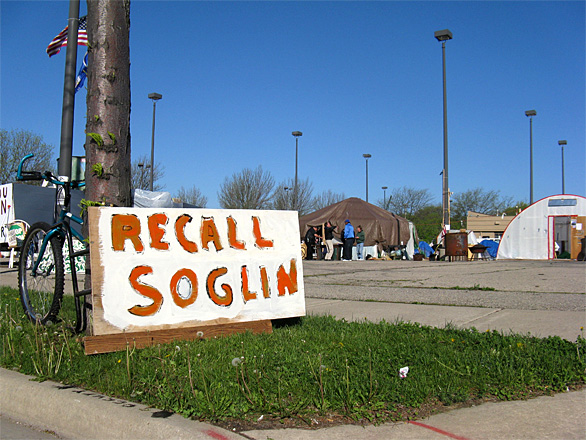I’m in Madison, Wisconsin, for a few days and finding out the different history of occupation and Occupy in what many people think of as the home of the movement. Here, I’m hearing about the ways in which the legacy of the occupation at the Capital have in fact mitigated the impact of the Occupy movement.
In some ways, what’s happened in Wisconsin is an interesting test case for those looking for demands, structure and leadership from Occupy. When Gov. Scott Walker launched his assault on public sector unions, the Teaching Assistants Association and other unions organized a response that galvanized thousands in February 2011. No one is quite sure how the occupation began–one version was that it originated with a queue to speak. But the energy of that protest has driven an extraordinary campaign that culminated with the ratification of a recall election for the governor and some state senators.
Nonetheless, matters are now poised. Polls show an even divide between Walker and his yet-to-be-decided Democratic opponent. Conversations here are centred around the elections, from Tammy Baldwin’s run for US Senate to the Madison House of Representatives seat currently held by Baldwin, and of course the recall. The difference with the decidedly unconcerned perspective of OWS in regard to the 2012 elections is noticeable and thoroughly understandable. Were I still a Wisconsin resident, as I once was, I would be electorally committed.
As a result of this unusual pattern, Occupy Madison is a very different phenomenon than elsewhere. For one thing, it still has an encampment. The tents stand on a disused parking-lot on the less favored East side of town. The encampment houses about 60 to 100 homeless people. The occupiers-by-choice are no longer part of the movement. While the occupiers have a GA and use the vocabulary of the movement, they are being considered by local authorities as a social services issue, rather than a political one.
Nonetheless, it was a surprise to many in Madison that the local mayor Paul Soglin, a long-tine Madison liberal who has held the office off and on since 1973, evicted Occupy Madison last Friday. His grounds were contractual: he had given a permit to the occupiers until April 30 and their efforts to extend the encampment were in breach of this agreement. From the account in the Isthmus, the local alternative paper, written by Joe Tarr (4/20/12: 5), the issue came down to how the movement was perceived. For Soglin, the campers were homeless people and Madison feels itself at risk from transient homeless people, who, it is believed, journey to the city from Chicago in search of benefits and other amenities. For others, even in the Common Council, this was a social movement even if the participants happened to be homeless.
So here’s the irony. In Madison, the city that many rightly think of as the origin of the Occupy movement in the US, with its inspiring occupation of the state Capitol, May Day will see the eviction of Occupy Madison, even as 115 other cities are marking a Day Without the 99%. Downtown, you can see shops like “Amsterdam,” better known for its fetish gear, with a window full of Occupy materials, general strike posters and T-shirts recalling the Wisconsin movement.
The stakes here are interesting, considerable and very different to New York. People are hoping to replace a very right-wing governor by means of an electoral coalition that includes all the public sector unions from the students to the police and the corrections officers. Perhaps that’s a viable working model of the 99%. Should that election fail, it may be the end of that model. Or it might be the beginning of a new version of it. Keep an eye on Wisconsin: for once the rhetoric of bell-weather state might be right.

